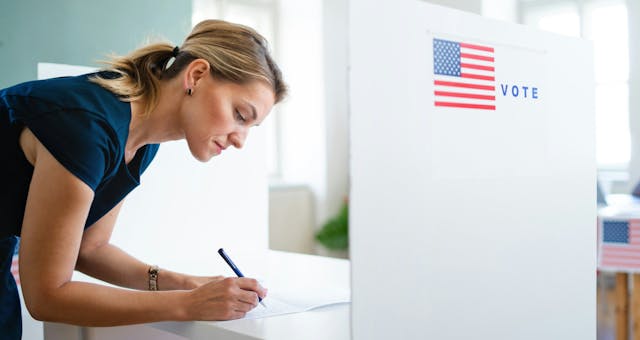Will E-Voting via Smartphone Promote Greater Election Participation?

With smartphone ownership being so common in the U.S., the questions surrounding electronic voting are becoming increasingly important. 39 percent of likely voters surveyed by Consumer Reports said they would choose voting by computer or mobile device over traditional methods. But despite the growing openness to electronic voting, e-voting opportunities have declined since the mid-2000s. Because states lack the funding to repair and replace newer voting machines, many have reverted to more traditional punch-card ballots. Some argue that older paper methods are less vulnerable to fraud, while others counter that more electronic voting would enable greater voter turnout. Here’s a more detailed look from both sides of the aisle at the question of whether allowing e-voting via smartphone would empower democracy more directly.
Support For E-voting
President Obama laid out a case for e-voting in a presentation to this year’s SXSW Interactive Festival in Austin, Texas. Pointing to the fact that half of eligible voters don’t vote, Obama called for redesigning voting technology to enable greater participation. He stated that the United States is the only advanced democracy that makes it difficult for people to vote, saying that it’s easier to order a pizza than to vote. Obama argued that online voting systems aren’t necessarily insecure and claimed that the lack of technological progress reflects a lack of desire on the part of politicians.
Everyone Counts CEO Lori Steele argues that electronic voting is actually more secure than traditional methods when military-grade encryption is used. Additionally, smartphones such as the iPhone 6 have encryption safeguards strong enough to daunt even federal investigators, which presents a formidable challenge for potential hackers. Other advocates point to the fact that all states already send ballots to overseas voters electronically and 32 allow some form of electronic ballot return via the internet, email or fax. Alabama Secretary of State John Merrill says e-voting makes it easier for armed service personnel to get their votes submitted on time, another point in favor of e-voting.
Arguments Against E-voting
Consumer Reports’ survey found that allowing e-voting would only increase voter turnout by 7 percent, a significant improvement but not dramatic enough to elicit a voter turnout of 50 percent. The survey found that the additional voting demographic would be predominantly female, white, aged 18 to 29 with some or no college education, with a household income below $50,000 and independent in party affiliation. While accounting for the voices of these voters is obviously important, it does not address the broader issue of low voter engagement among minorities and other demographics.
Additionally, electronic voting alone lacks the means for effective voting and recount supervision. For instance, in 2004, a North Carolina electronic voting machine lost 4,500 votes when it stopped recording votes in an election that was decided by fewer than 2,000 votes. Due to the lack of a paper trail, no recount was possible. This blunder led to over 60 percent of states requiring a paper trail, making a completely paperless voting process less imminent.
Security Concerns
Security is another major issue. In the wake of hacks against the DNC and Arizona and Illinois voter databases, Senate Minority Leader Harry Reid has called for the FBI to investigate whether Russia is tampering with U.S. elections. Foreign Policy cybersecurity writer Elias Groll argues that, while there is no solid evidence of Russian involvement, e-voting remains vulnerable to attack methods such as stealing and deleting voter databases and loading malware onto e-voting systems. Computer science professor Aviel Rubin adds that hackers could manipulate elections by targeting key districts with denial of service attacks that would keep certain online voters from connecting.
Rubin doesn’t see how online voting could be done securely, but other experts are more optimistic. Computer scientist Michael Shamos says that while cyberattacks on e-voting systems might succeed on a small scale, it would be difficult to successfully disrupt an election on a large scale. He points out that electronic voting machines are not connected to each other, making it impossible to spread viruses from one machine to another.
Photo Credit: mtkang / shutterstock.com


